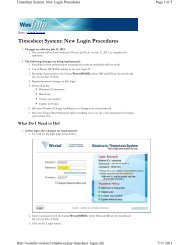The Addiction Behaviors Checklist: Validation of a New ... - Westat
The Addiction Behaviors Checklist: Validation of a New ... - Westat
The Addiction Behaviors Checklist: Validation of a New ... - Westat
You also want an ePaper? Increase the reach of your titles
YUMPU automatically turns print PDFs into web optimized ePapers that Google loves.
Vol. 32 No. 4 October 2006 <strong>Addiction</strong> <strong>Behaviors</strong> <strong>Checklist</strong>351pain patients: clinical criteria, incidence, and predictors.Clin J Pain 1997;13:150e155.9. Harden RN. Chronic opioid therapy: anotherreappraisal. APS Bull 2002;12.10. American Academy <strong>of</strong> Pain Medicine, AmericanPain Society, American Society <strong>of</strong> <strong>Addiction</strong> Medicine.Definitions related to the use <strong>of</strong> opioids forthe treatment <strong>of</strong> pain. Glenview, IL, 2001.11. Portenoy RK, Payne R. Acute and chronic pain.In: Lowinson J, Ruiz P, Millman R, Langrod J, eds.Substance abuse: A comprehensive textbook. Baltimore,MD: Williams and Wilkins, 1997: 563e590.12. Butler SF, Budman SH, McGee MD, et al. <strong>Addiction</strong>severity assessment tool: development <strong>of</strong> a self--report measure for clients in substance abusetreatment. Drug Alcohol Depend 2005;80:349e360.13. Adams LL, Gatchel RJ, Robinson RC, et al. Development<strong>of</strong> a self-report screening instrument forassessing potential opioid medication misuse inchronic pain patients. J Pain Symptom Manage2004;27:440e459.14. Butler SF, Budman SH, Fernandez K,Jamison RN. <strong>Validation</strong> <strong>of</strong> a screener and opioid assessmentmeasure for patients with chronic pain.Pain 2004;112:65e72.15. Michna E, Ross EL, Hynes WL, et al. Predictingaberrant drug behavior in patients treated forchronic pain: importance <strong>of</strong> abuse history. J PainSymptom Manage 2004;28:250e258.16. Compton P, Darakjian J, Miotto K. Screeningfor addiction in patients with chronic pain and‘‘problematic’’ substance use: evaluation <strong>of</strong> a pilotassessment tool. J Pain Symptom Manage 1998;16:355e363.17. Robinson RC, Gatchel RJ, Polatin P, et al.Screening for problematic prescription opioid use.Clin J Pain 2001;17:220e228.18. Schieffer BM, Pham Q, Labus J, et al. Pain medicationbeliefs and medication misuse in chronicpain. J Pain 2005;6:620e629.19. Weissman DE, Haddox JD. Opioid pseudoaddictiondaniatrogenic syndrome. Pain 1989;363e366.20. Gajraj N, Hervias-Sanz M. Opiate abuse orundertreatment? Clin J Pain 1998;14:90.21. Chabal C, Jacobson L, Mariano A, Chaney E.Opiate abuse or undertreatment? Clin J Pain 1998;14:90e91.22. Kirsh KL, Whitcomb LA, Donaghy K, Passik SD.Abuse and addiction issues in medically ill patientswith pain: attempts at clarification <strong>of</strong> terms and empiricalstudy. Clin J Pain 2002;18:S52eS60.Appendix<strong>Addiction</strong> <strong>Behaviors</strong> <strong>Checklist</strong>Instructions: Code only for patients prescribed opioid or sedative analgesics on behaviors exhibited‘‘since last visit’’ and ‘‘within the current visit’’ (NA ¼ not assessed)<strong>Addiction</strong> behaviorsdsince last visit1. Patient used illicit drugs or evidences problem drinking a Y N NA2. Patient has hoarded meds Y N NA3. Patient used more narcotic than prescribed Y N NA4. Patient ran out <strong>of</strong> meds early Y N NA5. Patient has increased use <strong>of</strong> narcotics Y N NA6. Patient used analgesics PRN when prescription is for time contingent use Y N NA7. Patient received narcotics from more than one provider Y N NA8. Patient bought meds on the streets Y N NA<strong>Addiction</strong> behaviorsdwithin current visit1. Patient appears sedated or confused (e.g., slurred speech, unresponsive) Y N NA2. Patient expresses worries about addiction Y N NA3. Patient expressed a strong preference for a specific type <strong>of</strong> analgesic orY N NAa specific route <strong>of</strong> administration4. Patient expresses concern about future availability <strong>of</strong> narcotic Y N NA5. Patient reports worsened relationships with family Y N NA6. Patient misrepresented analgesic prescription or use Y N NA7. Patient indicated she or he ‘‘needs’’ or ‘‘must have’’ analgesic meds Y N NA8. Discussion <strong>of</strong> analgesic meds was the predominant issue <strong>of</strong> visit Y N NA9. Patient exhibited lack <strong>of</strong> interest in rehab or self-management Y N NA10. Patient reports minimal/inadequate relief from narcotic analgesic Y N NA11. Patient indicated difficulty with using medication agreement Y N NAOther1. Significant others express concern over patient’s use <strong>of</strong> analgesics Y N NAa Item 1 original phrasing: (‘‘Patient used ETOH or illicit drugs’’), had a low correlation with global clinical judgment. This is possibly associatedwith difficulty in content interpretation, in that if a patient endorsed highly infrequent alcohol use, he or she would receive a positive rating onthis item, but not be considered as using the prescription opioid medications inappropriately. <strong>The</strong>refore, we include in this version <strong>of</strong> the ABCa suggested wording change for this item that specifies problem drinking as the criterion for alcohol use.







